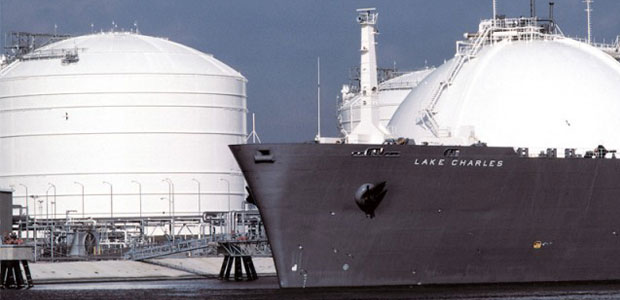
Natural Gas Exports
Keeping Pace In The LNG Race
By Brian S. Heslin and Tonya L. Mercer
CHARLOTTE, N.C.–The narrative of the American energy story has changed dramatically, from a nation dependent on foreign sources, to the promise of independence and the possibilities of net energy exportation.
The rich supply of accessible domestic natural gas has sparked a growing consensus that liquefied natural gas exports represent an opportunity for the United States to become a major player in the global energy sector. Over the past two years, the U.S. Department of Energy and the Federal Energy Regulatory Commission have moved more expeditiously to process applications to export LNG to countries that do not have a Free Trade Agreement with the United States–or non-FTA countries.
At the same time, the administration received sharp criticism for moving too slowly in approving LNG exports, and risking the nation’s opportunity. With increasing pressure to bring LNG exports to market, the DOE revised its review process for export applications from the lower 48 states this summer, and federal legislation was introduced to expedite approving additional projects. With the final approval of three LNG export projects, the United States expects LNG exports to start sailing from the lower 48 states to non-FTA countries by 2016. Additional projects have received conditional authorization from the DOE under its previous procedure, and more than two dozen LNG export applications remain pending.
So what is the viability of LNG exports as a means for the United States to secure its position in the global energy market, given the current export projects and the time needed to bring substantial volumes of U.S. LNG to market?
The Promise Of Exports
The record levels of natural gas and oil production from the American shale revolution have ushered in an era of energy abundance. The U.S. Energy Information Administration’s Annual Energy Outlook 2014 projected that total domestic natural gas production would grow from 67.5 billion cubic feet a day in 2015 to 102.6 Bcf/d in 2040. In 2014, U.S. natural gas production reached record levels at 70.9 Bcf/d on Oct. 24. Production of Marcellus Shale natural gas alone has doubled in two years and has increased by nearly 33 percent from 2013.
On the wings of this burgeoning natural gas supply, the United States has risen to its current position of strength as a contender in the global energy market. The nation expects to be a net exporter of natural gas in 2018–with the majority of growth attributable to LNG exports to Asian markets. The United States also projects it will become a net exporter of LNG in 2016, and reach a peak level of 3.5 trillion cubic feet annually in 2030. By 2040, total natural gas net exports are anticipated to be 5.8 Tcf, maintaining 3.5 Tcf of net LNG exports.
In the face of a global LNG market that has been projected to grow over 75 percent in the next 20 years, the United States seems ideally positioned to capture a significant portion of growing trade. Yet, with global competition anticipated to ramp up to approximately 17 Tcf of LNG export capacity by 2018, concerns have been raised about the government delaying approval for U.S. LNG export projects.
Global demand for natural gas fuels is expected to grow, particularly in Asian countries, including:
- India;
- Japan;
- South Korea; and
- China.
There is also a growth among European countries, including France, Spain and Italy. Japan, South Korea, Spain, China and India are leading LNG importers. India is forecasted to become the second largest LNG importer by 2017, and China is only a few years behind it.
But, the United States is not alone in the effort to capture a share of this growing LNG market. Export projects are underway in other countries, including Canada, Australia and Qatar; and they may challenge the United States to ramp up its LNG export capacity, before growing demand is met by other countries.
LNG export projects require significant investments of time and resources to obtain regulatory approval and build facilities capable of processing, storing and shipping LNG. The United States has an advantage over some other countries, as there are already 11 import facilities waiting to be converted into export facilities. Although conversion projects cost less than starting ones from scratch, it still requires billions of dollars, years of work, and government approvals and permits to transform these existing “brownfield” facilities into functioning export facilities.
For example, the U.S. Sabine Pass LNG project and the Cameron LNG facility still will require nearly four to five years to construct and ramp up business. The proposed Alaska LNG LLC project reflects the time required to build a new Alaskan project; the company plans to submit the FERC application in September 2016, begin construction in 2018-19, and have the facilities in service by 2024-25.
Shifting Market Dynamics
Global energy market dynamics continue to swing, with historic developments that may impact the United States’ position in the global natural gas market. On Nov. 9, China and Russia signed their second agreement for Russia to supply China with natural gas. This followed a May 2014 agreement for Russia to supply $400 billion of natural gas to China over a period of 30 years. By 2020, an estimated 17 percent of China’s natural gas could be supplied by Russia.
Projections for U.S. natural gas export growth are heavily dependent upon Asian demand for LNG, with increased net exports to Asia through 2030 constituting more than half of the rise in U.S. net natural gas exports projected by the EIA. Fluctuations in China’s natural gas demand will shape the narrative for the United States, and any other countries preparing to enter the export market.
Two weeks before the November agreement was signed, Lithuania heralded its first completed LNG import terminal, which it named the “Independence” as a symbol of the country’s ability to source gas from countries besides Russia. The Independence reportedly can process enough LNG to supply much of the surrounding Baltic States, and already has secured agreements to receive LNG from Norway.
Providing Europe with access to U.S. LNG to alleviate the countries’ reliance on Russian natural gas, and to obtain some leverage over Russia, has been an impetus behind recent measures to expedite U.S. LNG exports. Notably, Russia’s natural gas volumes that will be shipped to China under the new agreement are expected to surpass its exports to Europe; this also could reduce the impact of Western sanctions or other energy restrictions placed on Russia. Developments like these in global market dynamics will continue to influence potential domestic projects, making the United States’ entry into the global market at a significant level all the more pressing.
Current Export Projects
The DOE has recognized repeatedly the “transformative impact” that natural gas is having on the U.S. energy landscape. Along with a transformative impact, the government should expect transformative policy and regulation. LNG exportation was the area in the industry awaiting the most policy development a year ago. The U.S. regulatory approval process has been considered one of the greatest threats to LNG exports, drawing heavy criticism and driving the DOE and Congress to initiate changes to the process this year.
Section 3 of the Natural Gas Act of 1938, as amended, requires DOE authorization to export natural gas to any foreign country. The department must approve applications for LNG exports to non-FTA countries, unless such exports are determined not to be in public interest. It is the public interest determination that opens the door to substantial delay, as it requires an open comment period, opportunities for interested parties to intervene, and a substantially involved environmental review pursuant to the National Environmental Policy Act.
The NEPA Review process alone requires a substantial investment of resources, including involving multiple federal agencies and costing as much as $100 million. The NEPA Review is headed by FERC for facilities onshore and offshore facilities that are within state waters. The U.S. Department of Transportation’s Maritime Administration heads NEPA Review for offshore LNG terminals beyond state waters.
The DOE normally serves as a cooperating agency and must satisfy its own NEPA compliance requirements, even if it chooses to adopt the other agency’s environmental review document. Other cooperating agencies may include the U.S. Army Corps of Engineers, Coast Guard, Department of Transportation, and the Environmental Protection Agency, depending on their relevant jurisdiction. FERC is required to comply with and consider more than 11 federal environmental laws and regulations in its NEPA analysis.
Before Aug. 15, the DOE reviewed LNG export applications by when they were received, and it issued conditional authorizations still subject to NEPA Review and final regulatory approval. The first conditional authorization had been granted in May 2011 to Sabine Pass Liquefaction LLC, which subsequently was granted final authorization in 2012. Between May 2013 and July 2014, DOE picked up its pace and issued seven additional conditional authorizations:
- Freeport LNG Expansion LP under two separate orders;
- Lake Charles Exports LLC;
- Dominion Cove Point LNG LP;
- Cameron LNG LLC;
- Jordan Cove Energy Project LP; and
- LNG Develop. Co. LLC.
Facing accusations that it was threatening the nation’s position in the global LNG export market, the DOE initiated the revision of its export application review procedures in June 2014. After public comment, the DOE finalized the revised procedures under which the agency no longer grants conditional authorizations for LNG exports from the lower 48 states. Effective Aug. 15, the department reviews applications in the order they become ready for DOE final review, which is “when the DOE has sufficient information on which to base a public interest determination and when DOE has completed its NEPA review.”
DOE’s view that conditional authorizations were no longer useful as a matter of course was substantiated by the fact that there were proposed LNG export projects in the advanced stages of NEPA Review that had not received a conditional authorization from the DOE. However, the DOE still has the discretion to issue conditional authorizations in the future.
Although the department also cited the efficiency facilitated by the procedural change, the procedural change clearly served as a means for it to reframe the perception that it is the agency responsible for delaying U.S. LNG exports. The revised procedure promises that projects with true potential to propel the country into the export market will not be sidelined because of their original place in the application line.
In fact, shortly after finalizing its revised procedures, the department issued two final authorizations for Cameron LNG LLC and Carib Energy LLC to export natural gas products to non-FTA countries from their respective terminals in Louisiana and Florida. The DOE procedural change will facilitate more rapid review of viable projects, but there is no guarantee that the lead agency’s NEPA Review will take less time.
Toward The Finish Line
What is riding on America taking a lead position in the race to LNG exportation? It is anticipated that domestic LNG exports could create 60,000 additional jobs, as well as a $4 billion increase in the nation’s gross domestic product. LNG also provides the promise of source diversification to European nations, and at potentially better prices. Cheniere Energy Inc. says its Sabine Pass project alone is expected to provide 25 percent of gas imported by Spain.
The DOE’s revision of its application review procedures maximizes the opportunity of viable projects to insert the United States into the LNG export market. But, incremental approvals of LNG exports will continue to face opposition from those who argue that more exports will diminish domestic gas supply or result in higher prices.
To assist in its public interest determination, the department requested an updated study by the EIA titled Effect of Increased Levels of Liquefied Natural Gas Exports on U.S. Energy Markets, which was released in October 2014. The scenarios presented by the DOE assumed total LNG exports from the lower 48 states of 12 Bcf/d, 16 Bcf/d and 20 Bcf/d, with the exports ramping up at a rate of 2 Bcf/d each year beginning in 2015. Notably, the EIA concluded that increased LNG exports lead to increased gross domestic product, to the benefit of the nation; but more exports also created higher gas prices ranging from 4 to 11 percent for producers and 2 to 5 percent for residential and commercial customers.
The study also shows that increased natural gas production would be sufficient to meet the majority of increased demand for LNG exports, alleviating much of the concern regarding diversion of natural gas supply from utilities and other companies. The EIA categorized the DOE assumption that total LNG exports from the lower 48 reach 12 Bcf/d in 2020 as “extremely aggressive, indeed almost impossible”; and it suggested a more credible and realistic pace of LNG exports reaching 12 Bcf/d in 2023. The more realistic ramp-up scenario resulted in slightly lower impacts on gas prices in the early years and a delay in the amount of gas required to support additional exports. Yet, the EIA stressed that it stands by the even more conservative view of LNG export growth presented in its Annual Energy Outlook 2014.
To date, DOE has granted final approval for the cumulative export of up to 3.94 Bcf/d from three projects:
- Sabine Pass, with 2.2 Bcf/d;
- Cameron LNG, with 1.7 Bcf/d; and
- Carib Energy, with 0.04 Bcf/d.
The department conditionally has authorized exporting an additional 6.62 Bcf/d for 20 years. As of Oct. 21, there were 26 additional applications classified as under DOE review and one new application. The total proposed export volume for all applications received by the department as of Oct. 21 was 38.06 Bcf/d, which far surpasses even the highest level of exports suggested for the EIA study.
Most certainly, some of these export applications will fail to obtain final approval. And any further changes to export approval procedures will have to come from Congress, according to Energy Secretary Ernest Moniz.
Legislative efforts to expedite LNG export approvals were initiated earlier in the year; however, they have yet to bear any real fruit. The House passed HR 6–the Domestic Prosperity and Global Freedom Act–in June, which originally called for the immediate grant of any pending LNG export applications. HR 6 ultimately was passed with the requirement that the DOE issue a final decision on LNG export applications within 30 days after the conclusion of the NEPA Review. The bill is still pending Senate review.
On July 22, the Natural Gas Export Certainty Act was introduced in the Senate, seeking to expedite review of LNG export applications that have been pending for at least 180 days. It has been referred to the Senate Committee on Energy & Natural Resources without any further action to date. Following the DOE procedural change, the Senate Committee on Energy & Natural Resources noted the need for DOE and FERC to maintain positive momentum in reviewing LNG export applications.
With the November midterm election giving Republicans control of the Senate and the House, there may be more legislative efforts to help the United State expedite or simplify the LNG export approval process. The country’s hope of playing a primary role in the international natural gas markets seems promising. Beyond the threat of external competition, the nation’s LNG export industry will face domestic hurdles before it can take its place as a major player in the global market.
For other great articles about exploration, drilling, completions and production, subscribe to The American Oil & Gas Reporter and bookmark www.aogr.com.















